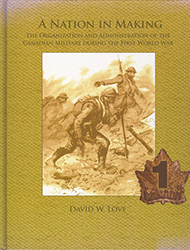BOOK REVIEWS

A Nation in Making: The Organization and Administration of the Canadian Military during the First World War
by David Love
Ottawa: Service Publications, 2012
Two volumes, Pp. xxi, 410. $89.95 (cloth)
ISBN 978-1-894581-72-1
For more information on accessing this file, please visit our help page.
Reviewed by John R. Grodzinski
This publication is an expanded edition of the author’s 1999 book A Call to Arms: The Organization and Administration of Canada’s Military in World War One. This was not a narrative history of our nation’s wartime effort. Rather, it outlined, in considerable detail, the organizational structure of the arms and services of the Canadian Expeditionary Force (CEF) and the method by which they were sustained in the field. The best description of this work is that it is the equivalent of a staff officer’s handbook on the organization and operation of the CEF in the field. Based upon constructive feedback and additional research, the author, who is an acknowledged amateur authority on the history of the Canadian Army in the Great War, revised the original work and expanded it with enough new information to warrant a second volume.
These changes have made A Nation in Making into a comprehensive examination of the organization principles of the army, the conduct of recruiting, home defence, the operation of detention camps, mobilization, training, and organization of the army. It also examines the naval and air services, Canadian service with Imperial formations and forces (Royal Navy, British Army and the Royal Air Force and its antecedents), assistance to allied forces, the auxiliary military services, and civilian war support organizations and initiatives. Several appendices also provide additional useful information, including a summary of military operations, medals, and decorations to the CEF, full-colour reproductions of formation insignia and patches, details on dress, weapons, and equipment, demobilization procedures, and a dictionary of trench slang. Any entry in these two volumes will leave readers with an appreciation of how things were done in units and formations as opposed to the specific stories of campaigns and battles.
A good example to illustrate this point exists in Chapter 21, which examines artillery and trench mortars. The Great War was noteworthy for changes in the command and employment of artillery, which also modified the role that corps and army headquarters played in operations. The author illustrates the evolution of Canadian artillery units, with reference to detailed charts and tables depicting the structural history of the Canadian Corps artillery. Critical to the operation of this combat arm was the support provided by the army service corps, which maintained several ammunition columns, oversaw the ammunition parks, and played a role in the movement of the guns, either by using horses or mechanical transport. Indeed, the logistical aspects of this large artillery organization are a fascinating topic that is very well covered. This chapter, like many of the others, uses numerous tables to depict additional detail, such as the technical characteristics of ordnance, ammunition stocks per gun, recruitment areas of each battery, and the ammunition columns. Other charts depict the communication from forward observers to the guns or mortars. The detail provided is impressive and all the other combat arms are presented in a similar manner.
Unfortunately, this is not the case for the Canadian Naval Service and the Canadian air services. Both topics are dealt with far too briefly; the growth of the navy itself was noteworthy as it expanded from almost nothing in 1914, to operating, almost four years later, nearly 200 vessels, a naval college, a wireless service responsible for 200 stations, two dockyard facilities, and various store depots. It had also begun forming a naval air service. In the author’s defence, however, documentation on the organization history of the Royal Canadian Navy or the air services during this period may be difficult, if not impossible, to locate.
Readers may also criticize the lack of notes. However, the extensive bibliography reveals the great number of manuals, published reports, and secondary sources consulted in the preparation of this study. Having prepared a similar, albeit less comprehensive examination of army formations in the Second World War, I can attest to the difficulty of citing the sources for every organization diagram, chart, or description.
Regardless of the lack of attention given to naval and air topics, A Nation in Making is an impressive reference work. No other single published work or Internet source offers the level of detail with respect to the organizational history of the Canadian services in the First World War as that which is presented in these two volumes, making it a work that Great War historians and students operational and sustainment doctrine during the Great War will find useful well into the future.
Major Grodzinski, CD, PhD, is an armoured officer and assistant professor of history at the Royal Military College of Canada. Although his primary interest rests with 18th and 19th Century conflicts, he does, from time to time, venture into contemporary history.



